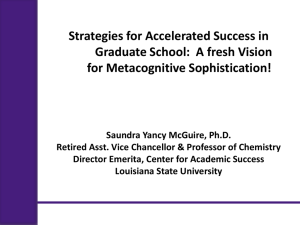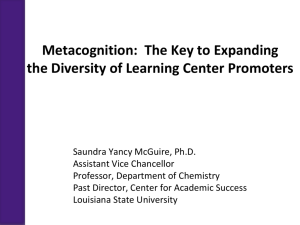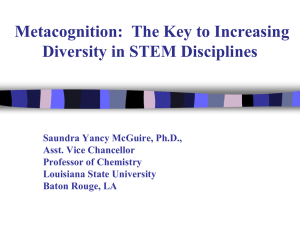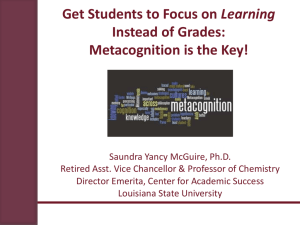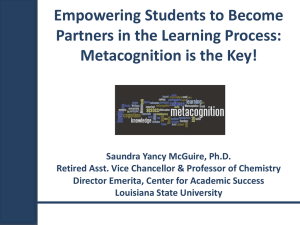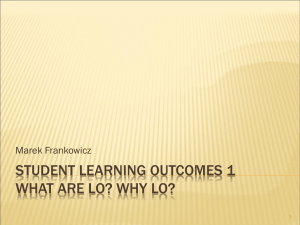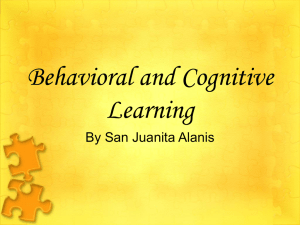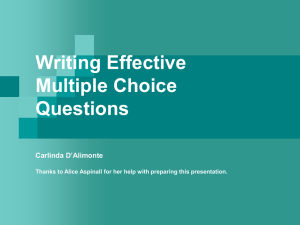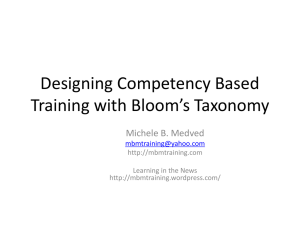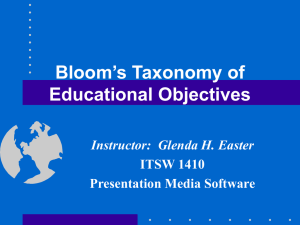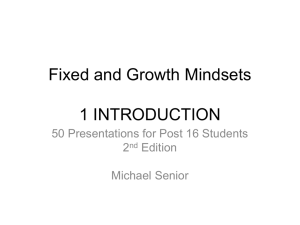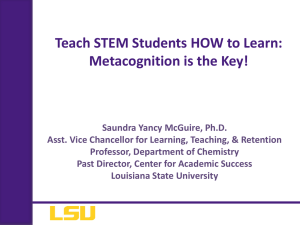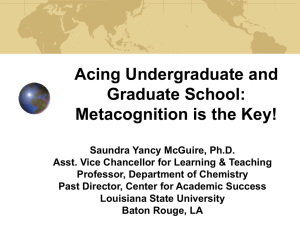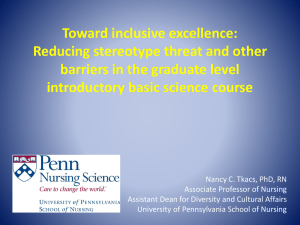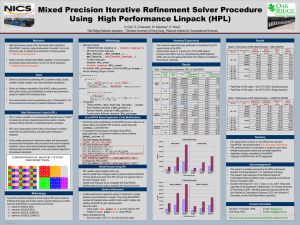Workshop - Center for Excellence in Science Education
advertisement
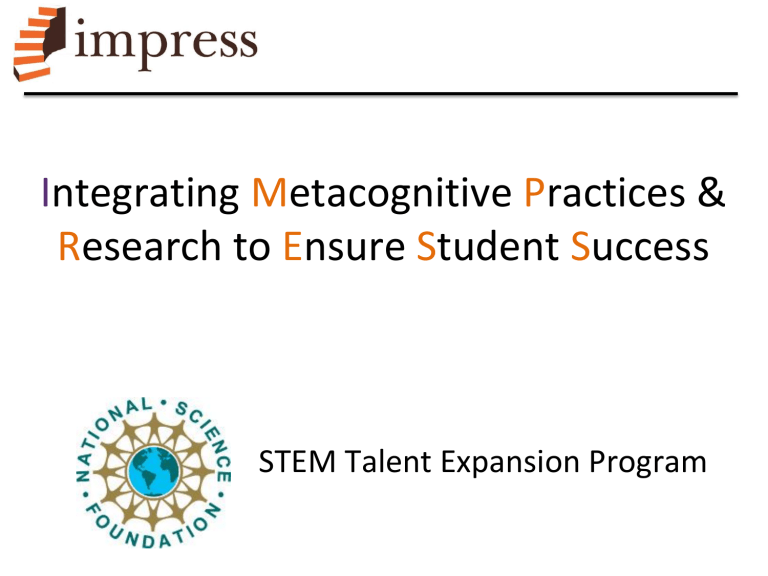
Integrating Metacognitive Practices & Research to Ensure Student Success STEM Talent Expansion Program Metacognition: awareness of one’s own knowledge • How one learns • Identity, culture, affect • Self-assessment: how well one has learned • Coherence of what is learned (from 1 domain to another, e.g. math/physics to engineering) • Lateral (concurrent) • Longitudinal (past to present to future) Overview • Improve retention Deaf/HoH & 1st gen STEM majors through explicit metacognitive activities • 2 week summer experience • 1st year courses • 2nd year Learning Assistant program • Colleges of Science, Engineering, Computer Science and Applied Science & Technology • 105 incoming students applied for summer (20 accepted), Fall courses (48 placed) EngineeringMathematicsChemistryBiology See the forest for the trees. Work with your peers to see the “big picture” in science and mathematics courses. Make the connection. See the relationship between what you will learn in all of your STEM courses. Prepare yourself. Engage in Enjoy yourself. Participate interdisciplinary mathematics in social activities and build and science activities before a network of friends before school starts. school starts. Challenge yourself. Work on challenging interdisciplinary science projects as a team. Get a head start. Build a relationship with RIT faculty and staff before school starts. PhysicsEnvironmental Science Computer Science Summer Experience • The Science of Climate Change • Journal writing • Quiet reflection • Group metacognition activities - Create a sign for metacognition - Stereotypes - What makes an expert? - Mindset - Self-assessment, unskilled/unaware - Personal struggles IMPRESS Activities Morning: Investigating climate change Afternoon: Reflection, journaling, metacognitive activities Student comments • Striking was their mention of developing empathy and understanding for others, listening skills and overcoming discomfort interacting with students who are different. • Hearing students were very excited by the presence of deaf students and saw their inclusion as a strength. • Deaf students appreciated the mix and did not want a program where they were separate. Fall Metacognition Course • Designed to guide students to think metacognitively about concurrent (introductory) STEM courses • Tue/Thurs, 75 minutes, co-taught with Dr. Elizabeth Hane, ecologist • 48 1st-year students (12/college) placed in class, 6 had participated in summer program • “Ethical perspectives” foundational course, satisfies Institute general education requirement Metacognitive Topics • Mindset • Bloom’s Taxonomy • Self-assessment (Unskilled & Unaware) • Experts and Novices • Transfer • Stereotype Threat • Student-centered learning • Diversity and Inclusivity in STEM Course Readings Class Topic Readings 2 Mindset Mindset (Dweck) Ch 1, 2 3 Bloom’s Taxonomy 4 Unskilled and Unaware Biology in Bloom (Crowe, 2008), Questions about Questions (Allen 2002) Unskilled & Unaware (Kruger & Dunning, 1999) 5 Self-assessment 10 Mindset How Chronic Self-Views Influence (and Mislead) SelfAssessments (Critcher & Dunning, 2009) Mindset (Dweck) Ch 3, 8 11 How People Learn - Intro Learning: From Speculation to Science. HPL, Ch. 1 12 HPL: Experts vs. Novices How Experts Differ from Novices. HPL, Ch. 2 13 HPL: Transfer Learning and Transfer. HPL, Ch. 3 (Bransford, 2002) 14 Stereotype Threat 22 Learning Style Preferences Stereotype and Gender Thin Ice: Stereotype Threat and Black College Students (Steele, 1999), Reducing the Gender Achievement Gap in College Science: Values Affirmation (Miyake, 2012) Matching Teaching Style to Learning Style may not help Students (Glenn 2009) Of Geeks and Girls, Grossman 2009 23 Class environment • Discussion-based • Small-groups w/worksheets • Class-wide guided discussion • Free-ranging, very loosely guided by syllabus • Need to formalize for secondary implementation Bloom’s Taxonomy • Categorizes types of thinking into 6 levels: • remembering • understanding • applying • analyzing • evaluating • creating • Categorize HW/test questions (“Blooming”) Bloom: Class Schedule • Class discussion • What we know about learning • Bloom’s taxonomy • At what level do students operate at in high school • 5 minute reflective period • Group work defining characteristics of Bloom levels • Class discussion on characteristics • Group work: Blooming HW questions at different levels • Generate questions at different Bloom levels At what level of Bloom’s does one operate to make A’s or B’s in high school? 44% 1. 2. 3. 4. 5. 6. Knowledge Comprehension Application Analysis Synthesis Evaluation 29% 21% 4% 0% 1 2 3 4 5 2% 6 At what level of Bloom’s do you think you’ll need to be to make an A in Chem 1201? 1. 2. 3. 4. 5. 6. 40% Knowledge Comprehension Application Analysis Synthesis Evaluation 23% 6% 1 11% 11% 9% 2 3 4 5 6 Bloom’s Worksheet Creating Evaluating Analyzing Applying Understanding Remembering http://www.odu.edu/educ/llschult/blooms_taxonomy.htm Blooming Questions • Students brought in homework questions from classes, discussed and Bloomed them • Generated new questions extending their homework questions to higher Bloom’s levels Stereotypes • Stereotype threat: fear of being stereotyped causes anxiety that leads to underperformance • Claude Steele discussing stereotype threat • Stereotypical environments, peers and readings depress women interest in computer science (Cheryan) Stereotype: Class Activities Below is a list of majors in Science & Technology: Physics Math Information Technology Biology Engineering Engineering Technology Chemistry Computer Science Network/System Administration Now findone someone in class and Choose from the abovewith list that major is not your What stereotypes exist for your major? Which dodo share How many these majoryour and list. write down theof first fivecharacteristics characteristics you embody? Which do you not? they that share? come to mind when thinking about someone with that major. Motivation: Class Activities In this activity we will alternate guided reflective periods with short writing prompts. During the reflective period think about the below question and how you will respond. Howsomeone would you characterize your mindset (growth, Find Why Think did ofyou else the choose introductory in the room your current who STEM had class major? a different that fixed, both?) this class?Why Why? Cite specific motivation youin for like choosing least. their do major you think (it could it is be a examples/evidence. different required? major). HowBe is it prepared connected to present with why a comparison between you chose the your two of major? you to the class. Coherence and Concept Maps • depict/emphasize relationships • Concepts connected by propositions • Use them to get students thinking about how different classes relate to one another: “lateral transfer map” Lateral Transfer Map Evolution of LTM Ethics and case Studies • 3 case studies • Genetically modified organisms • Ethics of teaching • National Center for Case Study Teaching in Science (U. of Buffalo) • Student groups (4) developed, presented argument about ethical reasoning • deontological (from rule) • teleological (from consequences) • ontological (from virtue) Ethics of Teaching • What responsibilities does a professor have towards students? • Choose a class theme (stereotype, mindset, transfer) and argue how it could present an ethical dilemma for a professor. Quiet reflective times Just think: The challenges of the disengaged mind Wilson et al., Science 2014 Participants typically did not enjoy spending 6 to 15 minutes in a room by themselves with nothing to do but think…and that many preferred to self-administer electric shocks (that they would pay to avoid) instead of being left alone with their thoughts. QRT in Class 16 Time (Minutes) 14 12 10 8 6 4 2 0 24.авг 09.сен 25.сен 11.окт 27.окт 12.ноя Reflections on QRT • No students complained about QRT in student evaluations • “Most, but not all, summer students enjoyed QRTs. Those who enjoyed them, really enjoyed them. Those who didn’t were bored.” • Most anectdata positive: • Post-QRT discussions richer • Led to more connected lateral transfer maps • Some students reported very productive QRT Conclusions/reflections • Impact unknown • Student feedback extremely positive • Cited comfort in expressing their opinions • 70% felt they learned a great deal • Some even cited QRT as a strength! • Need to export to secondary implementation! • 15 students continuing on in special First-year Writing course
